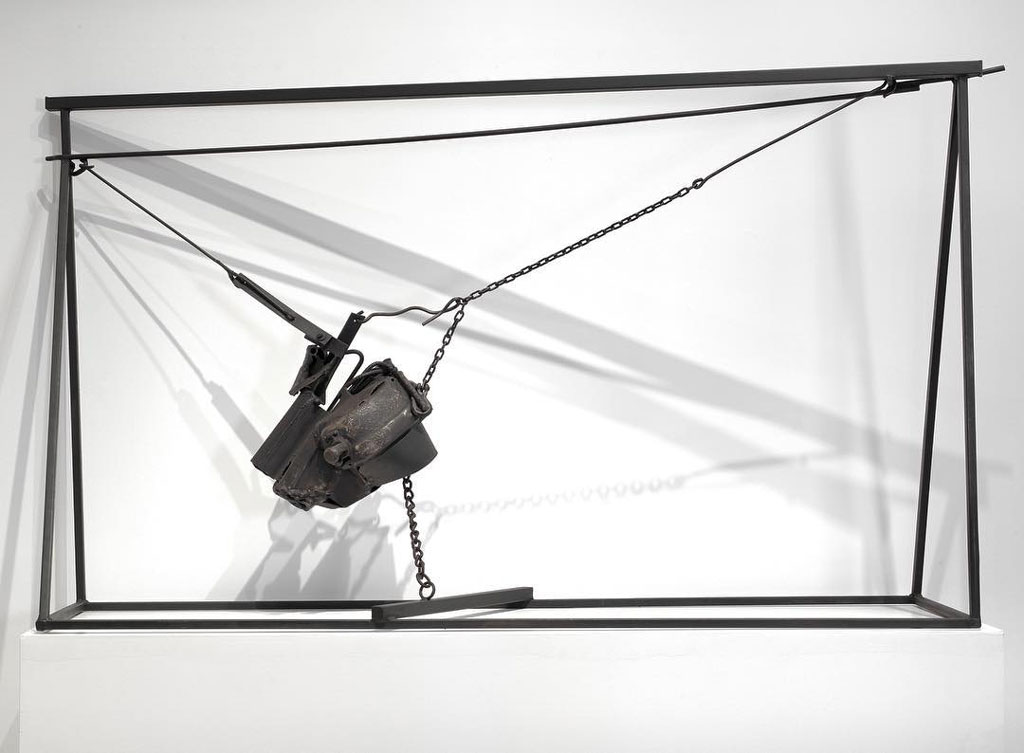ART-PRESENTATION: Melvin Edwards-Djeri Jef Fatou
 Melvin Edwards is a pioneer in the history of contemporary African-American art and sculpture. He makes sculpture through a process-oriented approach. Ordinarily, he works without sketches, although he is an inveterate and devoted maker of drawings. Melvin Edwards begins with the spark of an idea, then continues associatively, based on what he sees, handles, remembers. The journey itself lends definition and meaning to the resulting composition, which became a good lesson to recall in conversation, whenever we ended up far from the subject we thought was our destination.
Melvin Edwards is a pioneer in the history of contemporary African-American art and sculpture. He makes sculpture through a process-oriented approach. Ordinarily, he works without sketches, although he is an inveterate and devoted maker of drawings. Melvin Edwards begins with the spark of an idea, then continues associatively, based on what he sees, handles, remembers. The journey itself lends definition and meaning to the resulting composition, which became a good lesson to recall in conversation, whenever we ended up far from the subject we thought was our destination.
By Dimitris Lempesis
Photo: Alexander Gray Associates Archive
For more than 5 decades, Melvin Edwards has created evocative sculptures that juxtapose disparate steel elements to reflect on varied themes (oppression, labor, violence, the African Diaspora, etc.) and pay tribute to historic figures and friends. Melvin Edwards presents “Djeri Jef Fatou” at Alexander Gray Associates in Germantown, The work belongs to the artist’s series of “Discs”, which he began to create in Senegal in the early 2000s. Featuring a tangled amalgamation of nails and other industrial components, the work’s reductive welded structure expands on minimalism’s formalist legacy. At the same time, its title is a homage to Edwards’ close friend Fatou Ndiaye Sow (1937-2004), a Senegalese poet, teacher, and children’s book author. Ultimately “Djeri Jef Fatou” reveals Edwards’ deep engagement with Africa. Since first traveling to the continent in 1970, the artist has been committed to highlighting its incredible cultural diversity. As he concludes, “In my own generation of artists, and people I encountered there, I realized Africa was going to influence me not in terms of the ‘see something, get something visual’ that will influence your work, as much as a corroboration of generations feeling a similar need to create something new and different”. Edwards grew up in the home of his father’s mother, Coco, in Houston and then McNair in racially segregated Texas, before a move to Dayton, Ohio, where he attended integrated schools. His father’s work difficulties brought them back to Texas. He arrived in Los Angeles in 1955 to study and play footballat Los Angeles City College and the University of Southern California in Los Angeles. He kept something of the smashing, kinetic dynamism of the game in his head as he began studying abstract sculpture. He became interested in working with steel, with welding and hammering, with heating and bending, the raw physicality of it. He used steel he found at scrap yards and on the streets. In Los Angeles, he began his now decades-long series of “Lynch Fragments”, a series of wall-mounted assemblages welded together out of brown and black steel, in 1963 with a sculpture called “Some Bright Morning.” It featured (what appeared to be) a knife point and a chain with a lump on the end and could bring to mind a head or a handgrenade, emerging from a sort of pot hung on the wall. The 1960s and ‘70s were when Edwards developed many of the motifs that he’s spent the rest of his career exploring. He continued to make steel assemblages—interested in how implements could go from being farm tools to weapons and back to tools again. He began making large outdoor sculptures. He was part of a mural-painting collective called the Smokehouse Painters, organized by William T. Williams, that painted hard-edged geometric murals in Manhattan for two years beginning in 1968. Black artists under the banner of the Black Emergency Cultural Coalition were beginning to picket at the Metropolitan Museum and Whitney Museum calling for greater recognition of African-American artists. This was the environment Edwards entered, when he moved to New York City in 1967. Edwards already had a number of Museum shows to his credit, including shows in California and at the Studio Museum in Harlem. He was invited to be the first African-American sculptor to present a solo exhibition at the Whitney with a show there in March 1970. He featured artworks made from chain and barbed wire, intrigued by the idea of drawing with line in space, as well as with the connotations of the materials. Edwards began visiting Africa in the summer of 1970 as well, beginning with a trip to Ghana, Nigeria and Togo. His journeys to the continent would help expand his awareness of the accomplishments and setbacks, the commonalities and the possibilities of Africans and the diaspora. He would later keep a home there.
Info: Alexander Gray Associates Germantown, Alder & Co., 222 Main Street, Germantown, Duration: 5/7-5/8/19, Days & Hours: Fri-Sun 11:00-18:00, www.alexandergray.com





